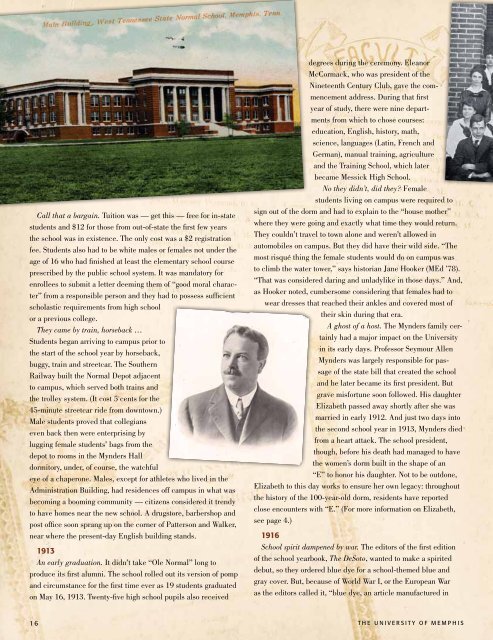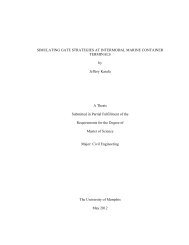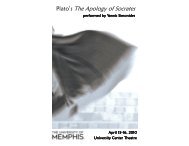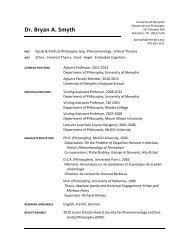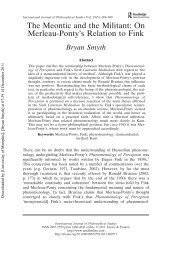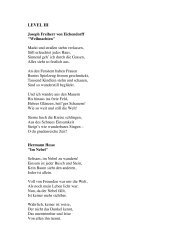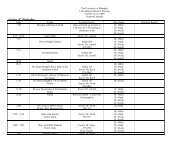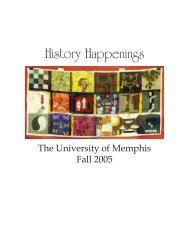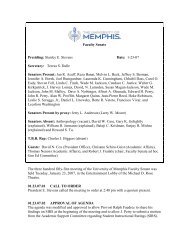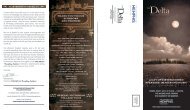By Greg Russell - University of Memphis
By Greg Russell - University of Memphis
By Greg Russell - University of Memphis
You also want an ePaper? Increase the reach of your titles
YUMPU automatically turns print PDFs into web optimized ePapers that Google loves.
Call that a bargain. Tuition was — get this — free for in-state<br />
students and $12 for those from out-<strong>of</strong>-state the first few years<br />
the school was in existence. The only cost was a $2 registration<br />
fee. Students also had to be white males or females not under the<br />
age <strong>of</strong> 16 who had finished at least the elementary school course<br />
prescribed by the public school system. It was mandatory for<br />
enrollees to submit a letter deeming them <strong>of</strong> “good moral character”<br />
from a responsible person and they had to possess sufficient<br />
scholastic requirements from high school<br />
or a previous college.<br />
They came by train, horseback …<br />
Students began arriving to campus prior to<br />
the start <strong>of</strong> the school year by horseback,<br />
buggy, train and streetcar. The Southern<br />
Railway built the Normal Depot adjacent<br />
to campus, which served both trains and<br />
the trolley system. (It cost 5 cents for the<br />
45-minute streetcar ride from downtown.)<br />
Male students proved that collegians<br />
even back then were enterprising by<br />
lugging female students’ bags from the<br />
depot to rooms in the Mynders Hall<br />
dormitory, under, <strong>of</strong> course, the watchful<br />
eye <strong>of</strong> a chaperone. Males, except for athletes who lived in the<br />
Administration Building, had residences <strong>of</strong>f campus in what was<br />
becoming a booming community — citizens considered it trendy<br />
to have homes near the new school. A drugstore, barbershop and<br />
post <strong>of</strong>fice soon sprang up on the corner <strong>of</strong> Patterson and Walker,<br />
near where the present-day English building stands.<br />
1913<br />
An early graduation. It didn’t take “Ole Normal” long to<br />
produce its first alumni. The school rolled out its version <strong>of</strong> pomp<br />
and circumstance for the first time ever as 19 students graduated<br />
on May 16, 1913. Twenty-five high school pupils also received<br />
16<br />
degrees during the ceremony. Eleanor<br />
McCormack, who was president <strong>of</strong> the<br />
Nineteenth Century Club, gave the commencement<br />
address. During that first<br />
year <strong>of</strong> study, there were nine departments<br />
from which to chose courses:<br />
education, English, history, math,<br />
science, languages (Latin, French and<br />
German), manual training, agriculture<br />
and the Training School, which later<br />
became Messick High School.<br />
No they didn’t, did they? Female<br />
students living on campus were required to<br />
sign out <strong>of</strong> the dorm and had to explain to the “house mother”<br />
where they were going and exactly what time they would return.<br />
They couldn’t travel to town alone and weren’t allowed in<br />
automobiles on campus. But they did have their wild side. “The<br />
most risqué thing the female students would do on campus was<br />
to climb the water tower,” says historian Jane Hooker (MEd ’78).<br />
“That was considered daring and unladylike in those days.” And,<br />
as Hooker noted, cumbersome considering that females had to<br />
wear dresses that reached their ankles and covered most <strong>of</strong><br />
their skin during that era.<br />
A ghost <strong>of</strong> a host. The Mynders family certainly<br />
had a major impact on the <strong>University</strong><br />
in its early days. Pr<strong>of</strong>essor Seymour Allen<br />
Mynders was largely responsible for passage<br />
<strong>of</strong> the state bill that created the school<br />
and he later became its first president. But<br />
grave misfortune soon followed. His daughter<br />
Elizabeth passed away shortly after she was<br />
married in early 1912. And just two days into<br />
the second school year in 1913, Mynders died<br />
from a heart attack. The school president,<br />
though, before his death had managed to have<br />
the women’s dorm built in the shape <strong>of</strong> an<br />
“E” to honor his daughter. Not to be outdone,<br />
Elizabeth to this day works to ensure her own legacy: throughout<br />
the history <strong>of</strong> the 100-year-old dorm, residents have reported<br />
close encounters with “E.” (For more information on Elizabeth,<br />
see page 4.)<br />
1916<br />
School spirit dampened by war. The editors <strong>of</strong> the first edition<br />
<strong>of</strong> the school yearbook, The DeSoto, wanted to make a spirited<br />
debut, so they ordered blue dye for a school-themed blue and<br />
gray cover. But, because <strong>of</strong> World War I, or the European War<br />
as the editors called it, “blue dye, an article manufactured in<br />
THE UNIVERSITY OF MEMPHIS


